mybatis_plus整合shiro
mybatis_plus整合shiro
注意:该项目要打开radis
1、前言
从零开始搭建一个项目骨架,最好选择合适,熟悉的技术,并且在未来易拓展,适合微服务化体系等。所以一般以Springboot作为我们的框架基础,这是离不开的了。
然后数据层,我们常用的是Mybatis,易上手,方便维护。但是单表操作比较困难,特别是添加字段或减少字段的时候,比较繁琐,所以这里我推荐使用Mybatis Plus(https://mp.baomidou.com/),为简化开发而生,只需简单配置,即可快速进行 CRUD 操作,从而节省大量时间。
作为一个项目骨架,权限也是我们不能忽略的,Shiro配置简单,使用也简单,所以使用Shiro作为我们的的权限。
考虑到项目可能需要部署多台,这时候我们的会话等信息需要共享,Redis是现在主流的缓存中间件,也适合我们的项目。
然后因为前后端分离,所以我们使用jwt作为我们用户身份凭证。
ok,我们现在就开始搭建我们的项目脚手架!
技术栈:
- SpringBoot
- mybatis plus
- shiro
- lombok
- redis
- hibernate validatior
- jwt
2、新建Springboot项目
这里,我们使用IDEA来开发我们项目,新建步骤比较简单,我们就不截图了。
开发工具与环境:
- idea
- mysql
- jdk 8
- maven3.3.9
新建好的项目结构如下,SpringBoot版本使用的目前最新的版本
pom的jar包导入如下:
<dependency>
<groupId>org.springframework.boot</groupId>
<artifactId>spring-boot-starter-web</artifactId>
</dependency>
<dependency>
<groupId>org.springframework.boot</groupId>
<artifactId>spring-boot-devtools</artifactId>
<scope>runtime</scope>
<optional>true</optional>
</dependency>
<dependency>
<groupId>org.projectlombok</groupId>
<artifactId>lombok</artifactId>
<optional>true</optional>
</dependency>- devtools:项目的热加载重启插件
- lombok:简化代码的工具
3、整合mybatis plus
接下来,我们来整合mybatis plus,让项目能完成基本的增删改查操作。步骤很简单:可以去官网看看:https://mp.baomidou.com/guide/install.html
第一步:导入jar包
pom中导入mybatis plus的jar包,因为后面会涉及到代码生成,所以我们还需要导入页面模板引擎,这里我们用的是freemarker。
<!--整合mybatis plus https://baomidou.com/-->
<dependency>
<groupId>com.baomidou</groupId>
<artifactId>mybatis-plus-boot-starter</artifactId>
<version>3.4.1</version>
</dependency>
<!--mp代码生成器-->
<dependency>
<groupId>com.baomidou</groupId>
<artifactId>mybatis-plus-generator</artifactId>
<version>3.4.1</version>
</dependency>
<dependency>
<groupId>org.springframework.boot</groupId>
<artifactId>spring-boot-starter-freemarker</artifactId>
</dependency>
<dependency>
<groupId>mysql</groupId>
<artifactId>mysql-connector-java</artifactId>
<scope>runtime</scope>
</dependency>第二步:然后去写配置文件
application.yml
server:
port: 8081
spring:
datasource:
url: jdbc:mysql://localhost:3306/vueblog?useUnicode=true&characterEncoding=utf-8&serverTimezone=Asia/Shanghai
username: root
password: root
driver-class-name: com.mysql.cj.jdbc.Driver
mybatis-plus:
mapper-locations: classpath*:/mapper/**Mapper.xml上面除了配置数据库的信息,还配置了myabtis plus的mapper的xml文件的扫描路径,这一步不要忘记了。 第三步:开启mapper接口扫描,添加分页插件
新建一个包:通过@mapperScan注解指定要变成实现类的接口所在的包,然后包下面的所有接口在编译之后都会生成相应的实现类。
com.imooc.config.MybatisPlusConfig
@Configuration
@EnableTransactionManagement
@MapperScan("com.imooc.mapper")
public class MybatisPlusConfig {
/**
* 分页插件
*/
@Bean
public MybatisPlusInterceptor mybatisPlusInterceptor() {
MybatisPlusInterceptor interceptor = new MybatisPlusInterceptor();
interceptor.addInnerInterceptor(new PaginationInnerInterceptor(DbType.MYSQL));
return interceptor;
}
}第四步:代码生成
如果你没再用其他插件,那么现在就已经可以使用mybatis plus了,官方给我们提供了一个代码生成器,然后我写上自己的参数之后,就可以直接根据数据库表信息生成entity、service、mapper等接口和实现类。
- com.imooc.CodeGenerator
package com.imooc;
import com.baomidou.mybatisplus.core.exceptions.MybatisPlusException;
import com.baomidou.mybatisplus.core.toolkit.StringPool;
import com.baomidou.mybatisplus.core.toolkit.StringUtils;
import com.baomidou.mybatisplus.generator.AutoGenerator;
import com.baomidou.mybatisplus.generator.InjectionConfig;
import com.baomidou.mybatisplus.generator.config.*;
import com.baomidou.mybatisplus.generator.config.po.TableInfo;
import com.baomidou.mybatisplus.generator.config.rules.NamingStrategy;
import com.baomidou.mybatisplus.generator.engine.FreemarkerTemplateEngine;
import java.util.ArrayList;
import java.util.List;
import java.util.Scanner;
// 演示例子,执行 main 方法控制台输入模块表名回车自动生成对应项目目录中
public class CodeGenerator {
/**
* <p>
* 读取控制台内容
* </p>
*/
public static String scanner(String tip) {
Scanner scanner = new Scanner(System.in);
StringBuilder help = new StringBuilder();
help.append("请输入" + tip + ":");
System.out.println(help.toString());
if (scanner.hasNext()) {
String ipt = scanner.next();
if (StringUtils.isNotBlank(ipt)) {
return ipt;
}
}
throw new MybatisPlusException("请输入正确的" + tip + "!");
}
public static void main(String[] args) {
// 代码生成器
AutoGenerator mpg = new AutoGenerator();
// 全局配置
GlobalConfig gc = new GlobalConfig();
String projectPath = System.getProperty("user.dir");
gc.setOutputDir(projectPath + "/src/main/java");
gc.setAuthor("练手");
gc.setOpen(false);
// gc.setSwagger2(true); 实体属性 Swagger2 注解
gc.setServiceName("%sService");
mpg.setGlobalConfig(gc);
// 数据源配置
DataSourceConfig dsc = new DataSourceConfig();
dsc.setUrl("jdbc:mysql://localhost:3306/vueblog?useUnicode=true&useSSL=false&characterEncoding=utf8&serverTimezone=Asia/Shanghai");
// dsc.setSchemaName("public");
dsc.setDriverName("com.mysql.cj.jdbc.Driver");
dsc.setUsername("root");
dsc.setPassword("root");
mpg.setDataSource(dsc);
// 包配置
PackageConfig pc = new PackageConfig();
// pc.setModuleName(scanner("模块名"));
pc.setParent("com.imooc");
mpg.setPackageInfo(pc);
// 自定义配置
InjectionConfig cfg = new InjectionConfig() {
@Override
public void initMap() {
// to do nothing
}
};
// 如果模板引擎是 freemarker
String templatePath = "/templates/mapper.xml.ftl";
// 如果模板引擎是 velocity
// String templatePath = "/templates/mapper.xml.vm";
// 自定义输出配置
List<FileOutConfig> focList = new ArrayList<>();
// 自定义配置会被优先输出
focList.add(new FileOutConfig(templatePath) {
@Override
public String outputFile(TableInfo tableInfo) {
// 自定义输出文件名 , 如果你 Entity 设置了前后缀、此处注意 xml 的名称会跟着发生变化!!
return projectPath + "/src/main/resources/mapper/" + pc.getModuleName()
+ "/" + tableInfo.getEntityName() + "Mapper" + StringPool.DOT_XML;
}
});
/*
cfg.setFileCreate(new IFileCreate() {
@Override
public boolean isCreate(ConfigBuilder configBuilder, FileType fileType, String filePath) {
// 判断自定义文件夹是否需要创建
checkDir("调用默认方法创建的目录,自定义目录用");
if (fileType == FileType.MAPPER) {
// 已经生成 mapper 文件判断存在,不想重新生成返回 false
return !new File(filePath).exists();
}
// 允许生成模板文件
return true;
}
});
*/
cfg.setFileOutConfigList(focList);
mpg.setCfg(cfg);
// 配置模板
TemplateConfig templateConfig = new TemplateConfig();
// 配置自定义输出模板
//指定自定义模板路径,注意不要带上.ftl/.vm, 会根据使用的模板引擎自动识别
// templateConfig.setEntity("templates/entity2.java");
// templateConfig.setService();
// templateConfig.setController();
templateConfig.setXml(null);
mpg.setTemplate(templateConfig);
// 策略配置
StrategyConfig strategy = new StrategyConfig();
strategy.setNaming(NamingStrategy.underline_to_camel);
strategy.setColumnNaming(NamingStrategy.underline_to_camel);
strategy.setEntityLombokModel(true);
strategy.setRestControllerStyle(true);
strategy.setInclude(scanner("表名,多个英文逗号分割").split(","));
strategy.setControllerMappingHyphenStyle(true);
strategy.setTablePrefix("m_");//动态调整
mpg.setStrategy(strategy);
mpg.setTemplateEngine(new FreemarkerTemplateEngine());
mpg.execute();
}
}在创建vueblog数据库中新建m_user和m_blog表
CREATE TABLE `m_user` (
`id` bigint(20) NOT NULL AUTO_INCREMENT,
`username` varchar(64) DEFAULT NULL,
`avatar` varchar(255) DEFAULT NULL,
`email` varchar(64) DEFAULT NULL,
`password` varchar(64) DEFAULT NULL,
`status` int(5) NOT NULL,
`created` datetime DEFAULT NULL,
`last_login` datetime DEFAULT NULL,
PRIMARY KEY (`id`),
KEY `UK_USERNAME` (`username`) USING BTREE
) ENGINE=InnoDB DEFAULT CHARSET=utf8;
CREATE TABLE `m_blog` (
`id` bigint(20) NOT NULL AUTO_INCREMENT,
`user_id` bigint(20) NOT NULL,
`title` varchar(255) NOT NULL,
`description` varchar(255) NOT NULL,
`content` longtext,
`created` datetime NOT NULL ON UPDATE CURRENT_TIMESTAMP,
`status` tinyint(4) DEFAULT NULL,
PRIMARY KEY (`id`)
) ENGINE=InnoDB AUTO_INCREMENT=11 DEFAULT CHARSET=utf8mb4;
INSERT INTO `vueblog`.`m_user` (`id`, `username`, `avatar`, `email`, `password`, `status`, `created`, `last_login`) VALUES ('1', 'markerhub', 'https://image-1300566513.cos.ap-guangzhou.myqcloud.com/upload/images/5a9f48118166308daba8b6da7e466aab.jpg', NULL, '96e79218965eb72c92a549dd5a330112', '0', '2020-04-20 10:44:01', NULL);运行CodeGenerator的main方法,输入表名:m_user,生成结果如下:
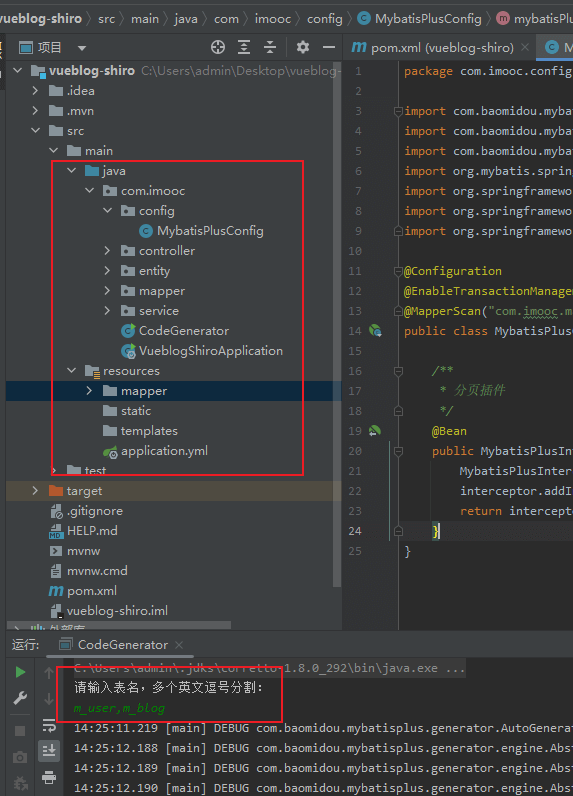
简洁!方便!经过上面的步骤,基本上我们已经把mybatis plus框架集成到项目中了。
在UserController中写个测试:
@RestController
@RequestMapping("/user")
public class UserController {
@Autowired
UserService userService;
@GetMapping("/{id}")
public Object test(@PathVariable("id") Long id) {
return userService.getById(id);
}
}访问:http://localhost:8081/user/1 获得结果如下,整合成功!

4、统一结果封装
这里我们用到了一个Result的类,这个用于我们的异步统一返回的结果封装。一般来说,结果里面有几个要素必要的
- 是否成功,可用code表示(如200表示成功,400表示异常)
- 结果消息
- 结果数据
所以可得到封装如下:
- com.imooc.common.Result
package com.imooc.common;
import lombok.Data;
import java.io.Serializable;
@Data
public class Result implements Serializable {
private int code; // 200是正常,非200表示异常
private String msg;
private Object data;
public static Result succ(Object data) {
return succ(200, "操作成功", data);
}
public static Result succ(int code, String msg, Object data) {
Result r = new Result();
r.setCode(code);
r.setMsg(msg);
r.setData(data);
return r;
}
public static Result fail(String msg) {
return fail(400, msg, null);
}
public static Result fail(String msg, Object data) {
return fail(400, msg, data);
}
public static Result fail(int code, String msg, Object data) {
Result r = new Result();
r.setCode(code);
r.setMsg(msg);
r.setData(data);
return r;
}
}在UserController修改成Result:
@RestController
@RequestMapping("/user")
public class UserController {
@Autowired
UserService userService;
@GetMapping("/{id}")
public Result test(@PathVariable("id") Long id) {
return Result.succ(userService.getById(id));
}
}结果

5、整合shiro+jwt,并会话共享
考虑到后面可能需要做集群、负载均衡等,所以就需要会话共享,而shiro的缓存和会话信息,我们一般考虑使用redis来存储这些数据,所以,我们不仅仅需要整合shiro,同时也需要整合redis。在开源的项目中,我们找到了一个starter可以快速整合shiro-redis,配置简单,这里也推荐大家使用。
而因为我们需要做的是前后端分离项目的骨架,所以一般我们会采用token或者jwt作为跨域身份验证解决方案。所以整合shiro的过程中,我们需要引入jwt的身份验证过程。
那么我们就开始整合:
我们使用一个shiro-redis-spring-boot-starter的jar包,具体教程可以看官方文档:https://github.com/alexxiyang/shiro-redis/blob/master/docs/README.md#spring-boot-starter
第一步:导入shiro-redis的starter包:还有jwt的工具包,以及为了简化开发,我引入了hutool工具包。
<dependency>
<groupId>org.crazycake</groupId>
<artifactId>shiro-redis-spring-boot-starter</artifactId>
<version>3.3.1</version>
</dependency>
<!-- hutool工具类-->
<dependency>
<groupId>cn.hutool</groupId>
<artifactId>hutool-all</artifactId>
<version>5.8.3</version>
</dependency>
<!-- jwt -->
<dependency>
<groupId>io.jsonwebtoken</groupId>
<artifactId>jjwt</artifactId>
<version>0.9.1</version>
</dependency>第二步:编写配置:
ShiroConfig
- com.imooc.config.ShiroConfig
package com.imooc.config;
import com.imooc.shiro.AccountRealm;
import com.imooc.shiro.JwtFilter;
import org.apache.shiro.mgt.SecurityManager;
import org.apache.shiro.session.mgt.SessionManager;
import org.apache.shiro.spring.web.ShiroFilterFactoryBean;
import org.apache.shiro.spring.web.config.DefaultShiroFilterChainDefinition;
import org.apache.shiro.spring.web.config.ShiroFilterChainDefinition;
import org.apache.shiro.web.mgt.DefaultWebSecurityManager;
import org.apache.shiro.web.session.mgt.DefaultWebSessionManager;
import org.crazycake.shiro.RedisCacheManager;
import org.crazycake.shiro.RedisSessionDAO;
import org.springframework.beans.factory.annotation.Autowired;
import org.springframework.context.annotation.Bean;
import org.springframework.context.annotation.Configuration;
import javax.servlet.Filter;
import java.util.HashMap;
import java.util.LinkedHashMap;
import java.util.Map;
@Configuration
public class ShiroConfig {
@Autowired
JwtFilter jwtFilter;
@Bean
public SessionManager sessionManager(RedisSessionDAO redisSessionDAO) {
DefaultWebSessionManager sessionManager = new DefaultWebSessionManager();
// inject redisSessionDAO
sessionManager.setSessionDAO(redisSessionDAO);
return sessionManager;
}
@Bean
public DefaultWebSecurityManager securityManager(AccountRealm accountRealm,
SessionManager sessionManager,
RedisCacheManager redisCacheManager) {
DefaultWebSecurityManager securityManager = new DefaultWebSecurityManager(accountRealm);
//inject sessionManager
securityManager.setSessionManager(sessionManager);
// inject redisCacheManager
securityManager.setCacheManager(redisCacheManager);
return securityManager;
}
@Bean
public ShiroFilterChainDefinition shiroFilterChainDefinition() {
DefaultShiroFilterChainDefinition chainDefinition = new DefaultShiroFilterChainDefinition();
Map<String, String> filterMap = new LinkedHashMap<>();
filterMap.put("/**", "jwt");
chainDefinition.addPathDefinitions(filterMap);
return chainDefinition;
}
@Bean("shiroFilterFactoryBean")
public ShiroFilterFactoryBean shiroFilterFactoryBean(SecurityManager securityManager,
ShiroFilterChainDefinition shiroFilterChainDefinition) {
ShiroFilterFactoryBean shiroFilter = new ShiroFilterFactoryBean();
shiroFilter.setSecurityManager(securityManager);
Map<String, Filter> filters = new HashMap<>();
filters.put("jwt", jwtFilter);
shiroFilter.setFilters(filters);
Map<String, String> filterMap = shiroFilterChainDefinition.getFilterChainMap();
shiroFilter.setFilterChainDefinitionMap(filterMap);
return shiroFilter;
}
}上面ShiroConfig,我们主要做了几件事情:
- 引入RedisSessionDAO和RedisCacheManager,为了解决shiro的权限数据和会话信息能保存到redis中,实现会话共享。
- 重写了SessionManager和DefaultWebSecurityManager,同时在DefaultWebSecurityManager中为了关闭shiro自带的session方式,我们需要设置为false,这样用户就不再能通过session方式登录shiro。后面将采用jwt凭证登录。
- 在ShiroFilterChainDefinition中,我们不再通过编码形式拦截Controller访问路径,而是所有的路由都需要经过JwtFilter这个过滤器,然后判断请求头中是否含有jwt的信息,有就登录,没有就跳过。跳过之后,有Controller中的shiro注解进行再次拦截,比如@RequiresAuthentication,这样控制权限访问。
那么,接下来,我们聊聊ShiroConfig中出现的AccountRealm,还有JwtFilter。
AccountRealm
AccountRealm是shiro进行登录或者权限校验的逻辑所在,算是核心了,我们需要重写3个方法,分别是
- supports:为了让realm支持jwt的凭证校验
- doGetAuthorizationInfo:权限校验
- doGetAuthenticationInfo:登录认证校验
我们先来总体看看AccountRealm的代码,然后逐个分析:
- com.imooc.shiro.AccountRealm
package com.imooc.shiro;
import cn.hutool.core.bean.BeanUtil;
import com.imooc.entity.User;
import com.imooc.service.UserService;
import com.imooc.util.JwtUtils;
import org.apache.shiro.authc.*;
import org.apache.shiro.authz.AuthorizationInfo;
import org.apache.shiro.realm.AuthorizingRealm;
import org.apache.shiro.subject.PrincipalCollection;
import org.springframework.beans.factory.annotation.Autowired;
import org.springframework.stereotype.Component;
@Component
public class AccountRealm extends AuthorizingRealm {
@Autowired
JwtUtils jwtUtils;
@Autowired
UserService userService;
@Override
public boolean supports(AuthenticationToken token) {
return token instanceof JwtToken;
}
@Override
protected AuthorizationInfo doGetAuthorizationInfo(PrincipalCollection principals) {
return null;
}
@Override
protected AuthenticationInfo doGetAuthenticationInfo(AuthenticationToken token) throws AuthenticationException {
JwtToken jwtToken = (JwtToken) token;
String userId = jwtUtils.getClaimByToken((String) jwtToken.getPrincipal()).getSubject();
User user = userService.getById(Long.valueOf(userId));
if (user == null) {
throw new UnknownAccountException("账户不存在");
}
if (user.getStatus() == -1) {
throw new LockedAccountException("账户已被锁定");
}
AccountProfile profile = new AccountProfile();
BeanUtil.copyProperties(user, profile);
return new SimpleAuthenticationInfo(profile, jwtToken.getCredentials(), getName());
}
}其实主要就是doGetAuthenticationInfo登录认证这个方法,可以看到我们通过jwt获取到用户信息,判断用户的状态,最后异常就抛出对应的异常信息,否者封装成SimpleAuthenticationInfo返回给shiro。 接下来我们逐步分析里面出现的新类:
1、shiro默认supports的是UsernamePasswordToken,而我们现在采用了jwt的方式,所以这里我们自定义一个JwtToken,来完成shiro的supports方法。
JwtToken
- com.imooc.shiro.JwtToken
package com.imooc.shiro;
import org.apache.shiro.authc.AuthenticationToken;
public class JwtToken implements AuthenticationToken {
private String token;
public JwtToken(String jwt) {
this.token = jwt;
}
@Override
public Object getPrincipal() {
return token;
}
@Override
public Object getCredentials() {
return token;
}
}2、JwtUtils是个生成和校验jwt的工具类,其中有些jwt相关的密钥信息是从项目配置文件中配置的:
com.imooc.utils.JwtUtils
package com.imooc.utils;
import io.jsonwebtoken.Claims;
import io.jsonwebtoken.Jwts;
import io.jsonwebtoken.SignatureAlgorithm;
import lombok.Data;
import lombok.extern.slf4j.Slf4j;
import org.springframework.boot.context.properties.ConfigurationProperties;
import org.springframework.stereotype.Component;
import java.util.Date;
/**
* jwt工具类
*/
@Slf4j
@Data
@Component
@ConfigurationProperties(prefix = "markerhub.jwt")
public class JwtUtils {
private String secret;
private long expire;
private String header;
/**
* 生成jwt token
*/
public String generateToken(long userId) {
Date nowDate = new Date();
//过期时间
Date expireDate = new Date(nowDate.getTime() + expire * 1000);
return Jwts.builder()
.setHeaderParam("typ", "JWT")
.setSubject(userId+"")
.setIssuedAt(nowDate)
.setExpiration(expireDate)
.signWith(SignatureAlgorithm.HS512, secret)
.compact();
}
// 获取jwt的信息
public Claims getClaimByToken(String token) {
try {
return Jwts.parser()
.setSigningKey(secret)
.parseClaimsJws(token)
.getBody();
}catch (Exception e){
log.debug("validate is token error ", e);
return null;
}
}
/**
* token是否过期
* @return true:过期
*/
public boolean isTokenExpired(Date expiration) {
return expiration.before(new Date());
}
}3、而在AccountRealm我们还用到了AccountProfile,这是为了登录成功之后返回的一个用户信息的载体,
AccountProfile
- com.imooc.shiro.AccountProfile
package com.imooc.shiro;
import lombok.Data;
import java.io.Serializable;
@Data
public class AccountProfile implements Serializable {
private Long id;
private String username;
private String avatar;
}第三步,ok,基本的校验的路线完成之后,我们需要少量的基本信息配置:
shiro-redis:
enabled: true
redis-manager:
host: 127.0.0.1:6379
markerhub:
jwt:
# 加密秘钥
secret: f4e2e52034348f86b67cde581c0f9eb5
# token有效时长,7天,单位秒
expire: 604800
header: token第四步:另外,如果你项目有使用spring-boot-devtools,需要添加一个配置文件,在resources目录下新建文件夹META-INF,然后新建文件spring-devtools.properties,这样热重启时候才不会报错。
- resources/META-INF/spring-devtools.properties
restart.include.shiro-redis=/shiro-[\\w-\\.]+jar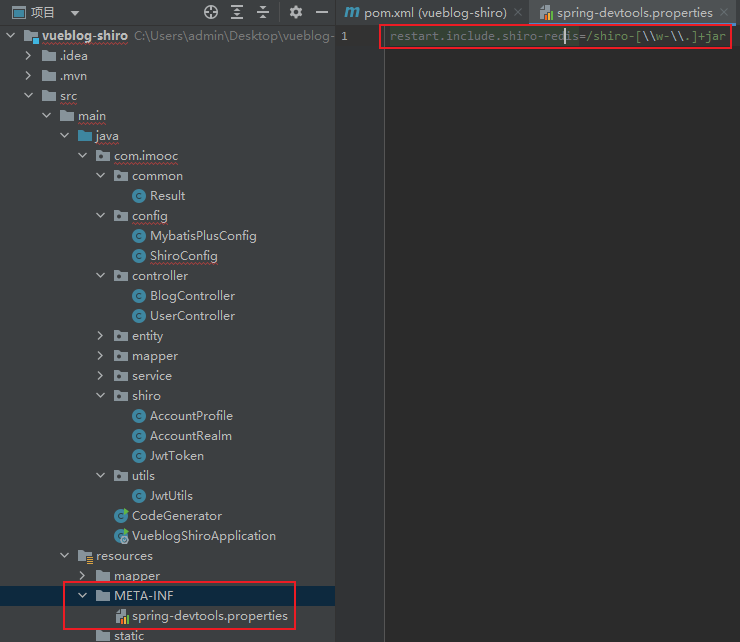
JwtFilter
第五步:定义jwt的过滤器JwtFilter。
这个过滤器是我们的重点,这里我们继承的是Shiro内置的AuthenticatingFilter,一个可以内置了可以自动登录方法的的过滤器,有些同学继承BasicHttpAuthenticationFilter也是可以的。
我们需要重写几个方法:
- createToken:实现登录,我们需要生成我们自定义支持的JwtToken
- onAccessDenied:拦截校验,当头部没有Authorization时候,我们直接通过,不需要自动登录;当带有的时候,首先我们校验jwt的有效性,没问题我们就直接执行executeLogin方法实现自动登录
- onLoginFailure:登录异常时候进入的方法,我们直接把异常信息封装然后抛出
- preHandle:拦截器的前置拦截,因为我们是前后端分析项目,项目中除了需要跨域全局配置之外,我们再拦截器中也需要提供跨域支持。这样,拦截器才不会在进入Controller之前就被限制了。
下面我们看看总体的代码:
- com.imooc.shiro.JwtFilter
package com.imooc.shiro;
import cn.hutool.json.JSONUtil;
import com.imooc.common.Result;
import com.imooc.utils.JwtUtils;
import io.jsonwebtoken.Claims;
import org.apache.shiro.authc.AuthenticationException;
import org.apache.shiro.authc.AuthenticationToken;
import org.apache.shiro.authc.ExpiredCredentialsException;
import org.apache.shiro.web.filter.authc.AuthenticatingFilter;
import org.apache.shiro.web.util.WebUtils;
import org.springframework.beans.factory.annotation.Autowired;
import org.springframework.stereotype.Component;
import org.springframework.util.StringUtils;
import org.springframework.web.bind.annotation.RequestMethod;
import javax.servlet.ServletRequest;
import javax.servlet.ServletResponse;
import javax.servlet.http.HttpServletRequest;
import javax.servlet.http.HttpServletResponse;
import java.io.IOException;
@Component
public class JwtFilter extends AuthenticatingFilter {
@Autowired
JwtUtils jwtUtils;
@Override
protected AuthenticationToken createToken(ServletRequest servletRequest, ServletResponse servletResponse) throws Exception {
// 获取 token
HttpServletRequest request = (HttpServletRequest) servletRequest;
String jwt = request.getHeader("Authorization");
if(StringUtils.isEmpty(jwt)) {
return null;
}
return new JwtToken(jwt);
}
@Override
protected boolean onAccessDenied(ServletRequest servletRequest, ServletResponse servletResponse) throws Exception {
HttpServletRequest request = (HttpServletRequest) servletRequest;
String jwt = request.getHeader("Authorization");
if(StringUtils.isEmpty(jwt)) {
return true;
} else {
// 校验jwt,判断是否已过期
Claims claim = jwtUtils.getClaimByToken(jwt);
if(claim == null || jwtUtils.isTokenExpired(claim.getExpiration())) {
throw new ExpiredCredentialsException("token已失效,请重新登录");
}
// 执行自动登录
return executeLogin(servletRequest, servletResponse);
}
}
@Override
protected boolean onLoginFailure(AuthenticationToken token, AuthenticationException e, ServletRequest request, ServletResponse response) {
HttpServletResponse httpServletResponse = (HttpServletResponse) response;
Throwable throwable = e.getCause() == null ? e : e.getCause();
Result result = Result.fail(throwable.getMessage());
String json = JSONUtil.toJsonStr(result);
try {
//处理登录失败的异常
httpServletResponse.getWriter().print(json);
} catch (IOException ioException) {
}
return false;
}
/**
* 对跨域提供支持
*/
@Override
protected boolean preHandle(ServletRequest request, ServletResponse response) throws Exception {
HttpServletRequest httpServletRequest = WebUtils.toHttp(request);
HttpServletResponse httpServletResponse = WebUtils.toHttp(response);
httpServletResponse.setHeader("Access-control-Allow-Origin", httpServletRequest.getHeader("Origin"));
httpServletResponse.setHeader("Access-Control-Allow-Methods", "GET,POST,OPTIONS,PUT,DELETE");
httpServletResponse.setHeader("Access-Control-Allow-Headers", httpServletRequest.getHeader("Access-Control-Request-Headers"));
// 跨域时会首先发送一个OPTIONS请求,这里我们给OPTIONS请求直接返回正常状态
if (httpServletRequest.getMethod().equals(RequestMethod.OPTIONS.name())) {
httpServletResponse.setStatus(org.springframework.http.HttpStatus.OK.value());
return false;
}
return super.preHandle(request, response);
}
}那么到这里,我们的shiro就已经完成整合进来了,并且使用了jwt进行身份校验。
6、异常处理
有时候不可避免服务器报错的情况,如果不配置异常处理机制,就会默认返回tomcat或者nginx的5XX页面,对普通用户来说,不太友好,用户也不懂什么情况。这时候需要我们程序员设计返回一个友好简单的格式给前端。
处理办法如下:通过使用@ControllerAdvice来进行统一异常处理,@ExceptionHandler(value = RuntimeException.class)来指定捕获的Exception各个类型异常 ,这个异常的处理,是全局的,所有类似的异常,都会跑到这个地方处理。
- com.imooc.common.GlobalExceptionHandler
步骤二、定义全局异常处理,@ControllerAdvice表示定义全局控制器异常处理,@ExceptionHandler表示针对性异常处理,可对每种异常针对性处理。
package com.imooc.common;
import lombok.extern.slf4j.Slf4j;
import org.apache.shiro.ShiroException;
import org.springframework.http.HttpStatus;
import org.springframework.validation.BindingResult;
import org.springframework.validation.ObjectError;
import org.springframework.web.bind.MethodArgumentNotValidException;
import org.springframework.web.bind.annotation.ExceptionHandler;
import org.springframework.web.bind.annotation.ResponseStatus;
import org.springframework.web.bind.annotation.RestControllerAdvice;
/**
* 全局异常处理
*/
@Slf4j
@RestControllerAdvice
public class GlobalExceptionHandler {
// 捕捉shiro的异常
@ResponseStatus(HttpStatus.UNAUTHORIZED)
@ExceptionHandler(value = ShiroException.class)
public Result handler(ShiroException e) {
log.error("运行时异常:----------------{}", e);
return Result.fail(401, e.getMessage(), null);
}
/**
* @Validated 校验错误异常处理
*/
@ResponseStatus(HttpStatus.BAD_REQUEST)
@ExceptionHandler(value = MethodArgumentNotValidException.class)
public Result handler(MethodArgumentNotValidException e) {
log.error("实体校验异常:----------------{}", e);
BindingResult bindingResult = e.getBindingResult();
ObjectError objectError = bindingResult.getAllErrors().stream().findFirst().get();
return Result.fail(objectError.getDefaultMessage());
}
/**
* 处理Assert的异常
*/
@ResponseStatus(HttpStatus.BAD_REQUEST)
@ExceptionHandler(value = IllegalArgumentException.class)
public Result handler(IllegalArgumentException e) {
log.error("Assert异常:----------------{}", e);
return Result.fail(e.getMessage());
}
@ResponseStatus(HttpStatus.BAD_REQUEST)
@ExceptionHandler(value = RuntimeException.class)
public Result handler(RuntimeException e) {
log.error("运行时异常:----------------{}", e);
return Result.fail(e.getMessage());
}
}上面我们捕捉了几个异常:
- ShiroException:shiro抛出的异常,比如没有权限,用户登录异常
- IllegalArgumentException:处理Assert的异常
- MethodArgumentNotValidException:处理实体校验的异常
- RuntimeException:捕捉其他异常
UserController编写index接口测试
package com.imooc.controller;
import com.imooc.common.Result;
import com.imooc.service.UserService;
import org.springframework.beans.factory.annotation.Autowired;
import org.springframework.web.bind.annotation.GetMapping;
import org.springframework.web.bind.annotation.RequestMapping;
import org.springframework.web.bind.annotation.RestController;
/**
* 前端控制器
*/
@RestController
@RequestMapping("/user")
public class UserController {
@Autowired
UserService userService;
@GetMapping("index")
public Result index() {
return Result.succ(userService.getById(1L));
}
}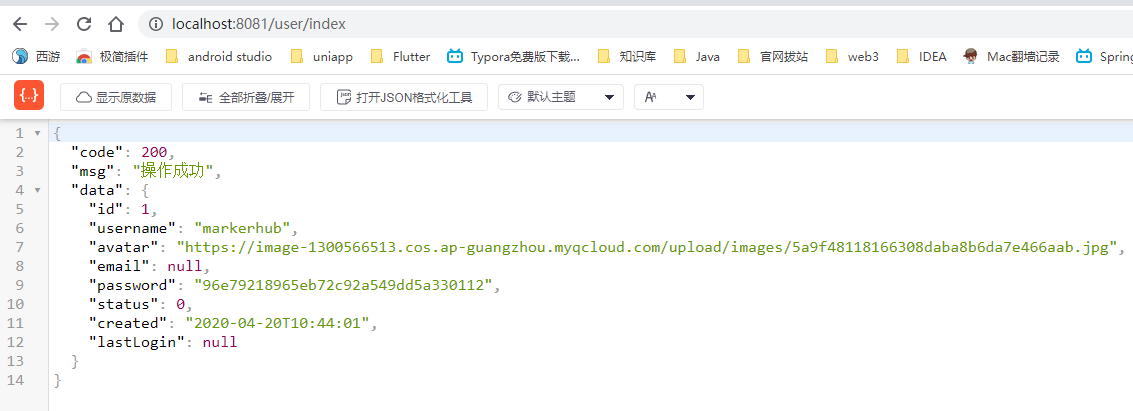
这里看出来是可以访问的
然后我们添加一个注解**@RequiresAuthentication**,告诉它需要登录才能访问
package com.imooc.controller;
import com.imooc.common.Result;
import com.imooc.service.UserService;
import org.apache.shiro.authz.annotation.RequiresAuthentication;
import org.springframework.beans.factory.annotation.Autowired;
import org.springframework.web.bind.annotation.GetMapping;
import org.springframework.web.bind.annotation.RequestMapping;
import org.springframework.web.bind.annotation.RestController;
/**
* 前端控制器
*/
@RestController
@RequestMapping("/user")
public class UserController {
@Autowired
UserService userService;
@RequiresAuthentication
@GetMapping("index")
public Result index() {
return Result.succ(userService.getById(1L));
}
}然后请求接口就无法访问了,在全局异常中就已经捕捉shiro的异常
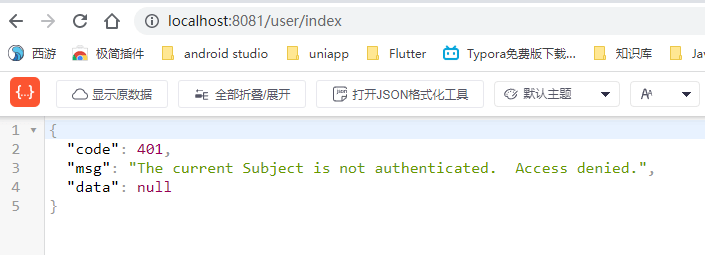
7、实体校验
当我们表单数据提交的时候,前端的校验我们可以使用一些类似于jQuery Validate等js插件实现,而后端我们可以使用Hibernate validatior来做校验。
我们使用springboot框架作为基础,那么就已经自动集成了Hibernate validatior。
那么用起来啥样子的呢?
<dependency>
<groupId>org.hibernate.validator</groupId>
<artifactId>hibernate-validator</artifactId>
<version>6.0.18.Final</version>
</dependency>第一步:首先在实体的属性上添加对应的校验规则,比如:
com.imooc.entity.User
package com.imooc.entity;
import com.baomidou.mybatisplus.annotation.IdType;
import com.baomidou.mybatisplus.annotation.TableId;
import com.baomidou.mybatisplus.annotation.TableName;
import lombok.Data;
import lombok.EqualsAndHashCode;
import javax.validation.constraints.Email;
import javax.validation.constraints.NotBlank;
import java.io.Serializable;
import java.time.LocalDateTime;
@Data
@EqualsAndHashCode(callSuper = false)
@TableName("m_user")
public class User implements Serializable {
private static final long serialVersionUID = 1L;
@TableId(value = "id", type = IdType.AUTO)
private Long id;
@NotBlank(message = "昵称不能为空")
private String username;
private String avatar;
@NotBlank(message = "邮箱不能为空")
@Email(message = "邮箱格式不正确")
private String email;
private String password;
private Integer status;
private LocalDateTime created;
private LocalDateTime lastLogin;
}第二步 :这里我们使用**@Validated**注解方式,如果实体不符合要求,系统会抛出异常,那么我们的异常处理中就捕获到MethodArgumentNotValidException。
com.imooc.controller.UserController
@PostMapping("/save") public Result save(@Validated @RequestBody User user) { return Result.succ(user); }
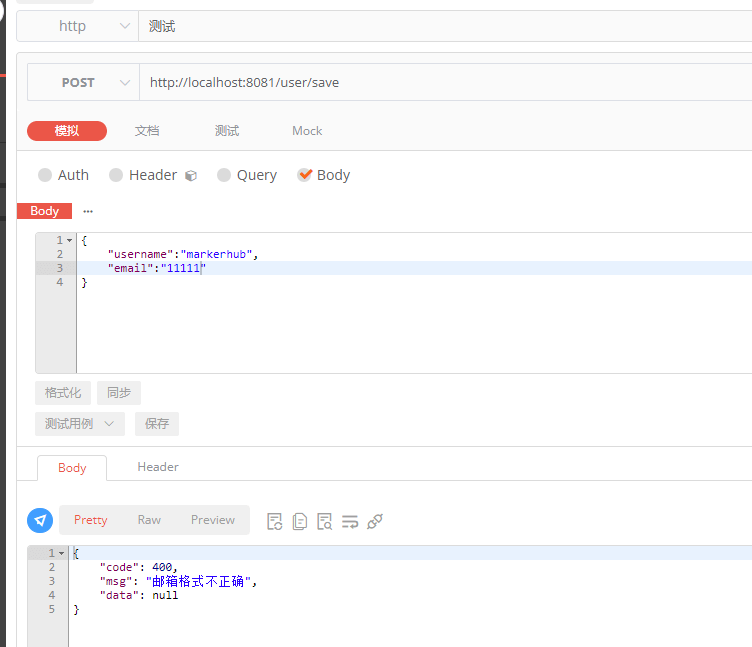
8、跨域问题
因为是前后端分析,所以跨域问题是避免不了的,我们直接在后台进行全局跨域处理:
- com.imooc.config.CorsConfig
package com.imooc.config;
import org.springframework.context.annotation.Configuration;
import org.springframework.web.cors.CorsConfiguration;
import org.springframework.web.servlet.config.annotation.CorsRegistry;
import org.springframework.web.servlet.config.annotation.WebMvcConfigurer;
/**
* 解决跨域问题
*/
@Configuration
public class CorsConfig implements WebMvcConfigurer {
private CorsConfiguration buildConfig() {
CorsConfiguration corsConfiguration = new CorsConfiguration();
corsConfiguration.addAllowedOrigin("*");
corsConfiguration.addAllowedHeader("*");
corsConfiguration.addAllowedMethod("*");
corsConfiguration.addExposedHeader("Authorization");
return corsConfiguration;
}
@Override
public void addCorsMappings(CorsRegistry registry) {
registry.addMapping("/**")
.allowedOrigins("*")
// .allowCredentials(true)
.allowedMethods("GET", "POST", "DELETE", "PUT")
.maxAge(3600);
}
}ok,因为我们系统开发的接口比较简单,所以我就不集成swagger2啦,也比较简单而已。下面我们就直接进入我们的正题,进行编写登录接口。
9、登录接口开发
登录的逻辑其实很简答,只需要接受账号密码,然后把用户的id生成jwt,返回给前端,为了后续的jwt的延期,所以我们把jwt放在header上。具体代码如下:
- com.imooc.controller.AccountController
package com.imooc.controller;
import cn.hutool.core.map.MapUtil;
import cn.hutool.crypto.SecureUtil;
import com.baomidou.mybatisplus.core.conditions.query.QueryWrapper;
import com.imooc.common.LoginDto;
import com.imooc.common.Result;
import com.imooc.entity.User;
import com.imooc.service.UserService;
import com.imooc.utils.JwtUtils;
import org.apache.shiro.SecurityUtils;
import org.apache.shiro.authz.annotation.RequiresAuthentication;
import org.springframework.beans.factory.annotation.Autowired;
import org.springframework.util.Assert;
import org.springframework.validation.annotation.Validated;
import org.springframework.web.bind.annotation.GetMapping;
import org.springframework.web.bind.annotation.PostMapping;
import org.springframework.web.bind.annotation.RequestBody;
import org.springframework.web.bind.annotation.RestController;
import javax.servlet.http.HttpServletResponse;
@RestController
public class AccountController {
@Autowired
UserService userService;
@Autowired
JwtUtils jwtUtils;
@PostMapping("/login")
public Result login(@Validated @RequestBody LoginDto loginDto, HttpServletResponse response) {
User user = userService.getOne(new QueryWrapper<User>().eq("username", loginDto.getUsername()));
Assert.notNull(user, "用户不存在");
if(!user.getPassword().equals(SecureUtil.md5(loginDto.getPassword()))){
return Result.fail("密码不正确");
}
Result.fail("密码不正确");
String jwt = jwtUtils.generateToken(user.getId());
response.setHeader("Authorization", jwt);
response.setHeader("Access-control-Expose-Headers", "Authorization");
return Result.succ(MapUtil.builder()
.put("id", user.getId())
.put("username", user.getUsername())
.put("avatar", user.getAvatar())
.put("email", user.getEmail())
.map()
);
}
@RequiresAuthentication
@GetMapping("/logout")
public Result logout() {
SecurityUtils.getSubject().logout();
return Result.succ(null);
}
}登录接口校验规则
com.imooc.common.LoginDto
package com.imooc.common;
import lombok.Data;
import javax.validation.constraints.NotBlank;
import java.io.Serializable;
@Data
public class LoginDto implements Serializable {
@NotBlank(message = "昵称不能为空")
private String username;
@NotBlank(message = "密码不能为空")
private String password;
}请求接口后,结果如下
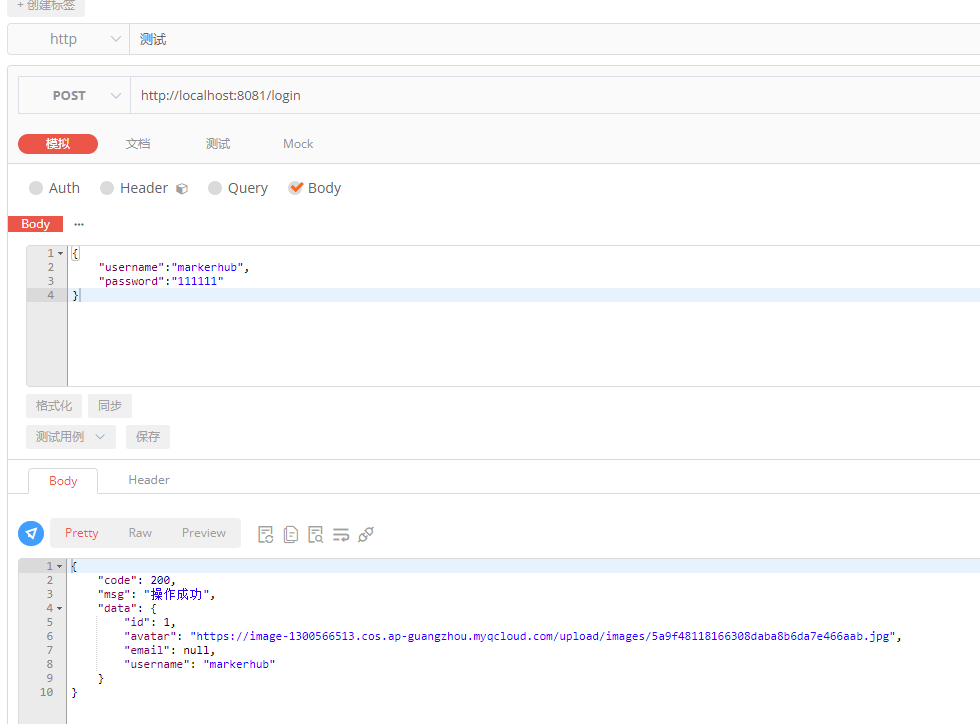
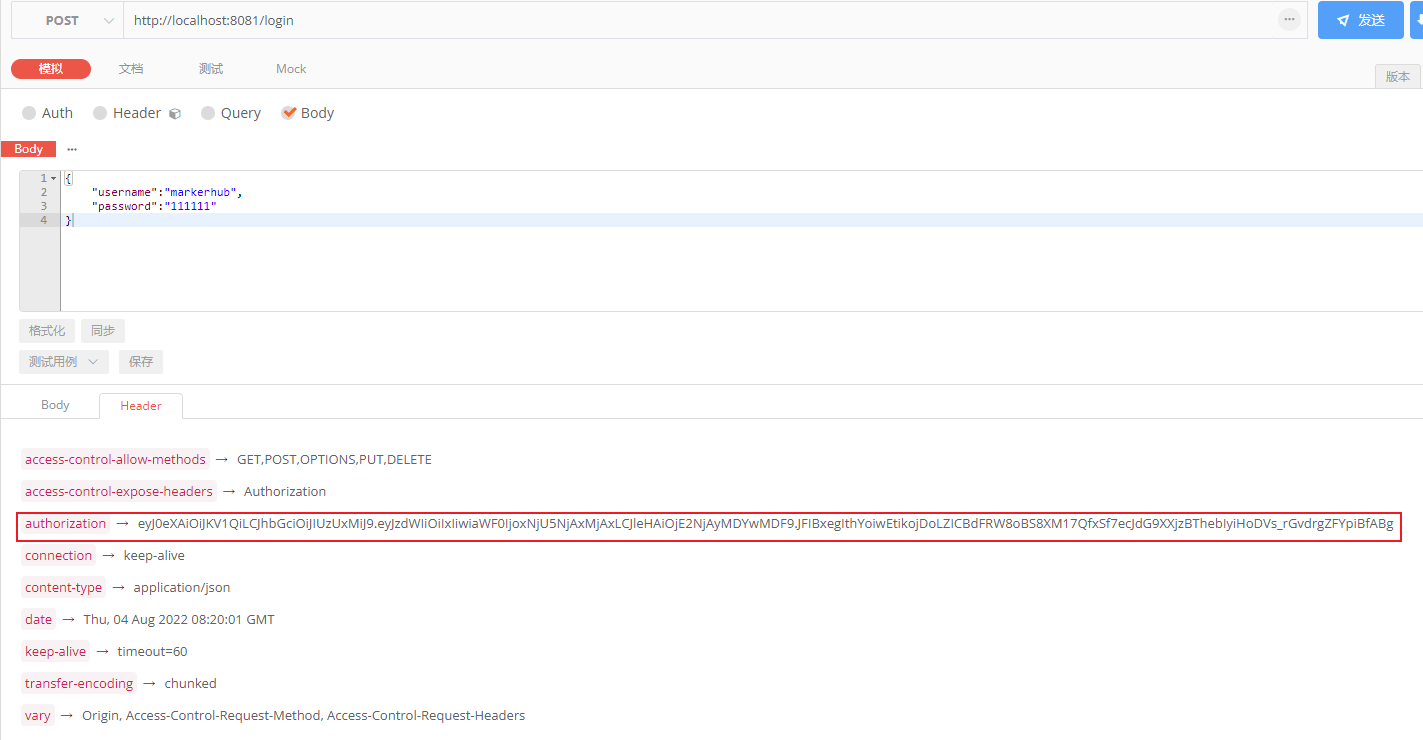
10、博客接口开发
我们的骨架已经完成,接下来,我们就可以添加我们的业务接口了,下面我以一个简单的博客列表、博客详情页为例子开发:
- com.imooc.controller.BlogController
package com.imooc.controller;
import cn.hutool.core.bean.BeanUtil;
import cn.hutool.core.lang.Assert;
import com.baomidou.mybatisplus.core.conditions.query.QueryWrapper;
import com.baomidou.mybatisplus.core.metadata.IPage;
import com.baomidou.mybatisplus.extension.plugins.pagination.Page;
import com.imooc.common.Result;
import com.imooc.entity.Blog;
import com.imooc.service.BlogService;
import com.imooc.utils.ShiroUtil;
import org.apache.shiro.authz.annotation.RequiresAuthentication;
import org.springframework.beans.factory.annotation.Autowired;
import org.springframework.validation.annotation.Validated;
import org.springframework.web.bind.annotation.*;
import java.time.LocalDateTime;
/**
* 前端控制器
*/
@RestController
public class BlogController {
@Autowired
BlogService blogService;
@GetMapping("/blogs")
public Result list(@RequestParam(defaultValue = "1") Integer currentPage) {
Page page = new Page(currentPage, 5);
IPage pageData = blogService.page(page, new QueryWrapper<Blog>().orderByDesc("created"));
return Result.succ(pageData);
}
@GetMapping("/blog/{id}")
public Result detail(@PathVariable(name = "id") Long id) {
Blog blog = blogService.getById(id);
Assert.notNull(blog, "该博客已被删除");
return Result.succ(blog);
}
@RequiresAuthentication//需要登录才能访问
@PostMapping("/blog/edit")
public Result edit(@Validated @RequestBody Blog blog) {
Blog temp = null;
if(blog.getId() != null) {
temp = blogService.getById(blog.getId());
// 只能编辑自己的文章
System.out.println(ShiroUtil.getProfile().getId());
Assert.isTrue(temp.getUserId().longValue() == ShiroUtil.getProfile().getId().longValue(), "没有权限编辑");
} else {
temp = new Blog();
temp.setUserId(ShiroUtil.getProfile().getId());
temp.setCreated(LocalDateTime.now());
temp.setStatus(0);
}
BeanUtil.copyProperties(blog, temp, "id", "userId", "created", "status");
blogService.saveOrUpdate(temp);
return Result.succ(null);
}
}com.imooc.utils.ShiroUtil
package com.imooc.utils;
import com.imooc.shiro.AccountProfile;
import org.apache.shiro.SecurityUtils;
public class ShiroUtil {
public static AccountProfile getProfile() {
return (AccountProfile) SecurityUtils.getSubject().getPrincipal();
}
}注意@RequiresAuthentication说明需要登录之后才能访问的接口,其他需要权限的接口可以添加shiro的相关注解。 接口比较简单,我们就不多说了,基本增删改查而已。注意的是edit方法是需要登录才能操作的受限资源。
测试接口
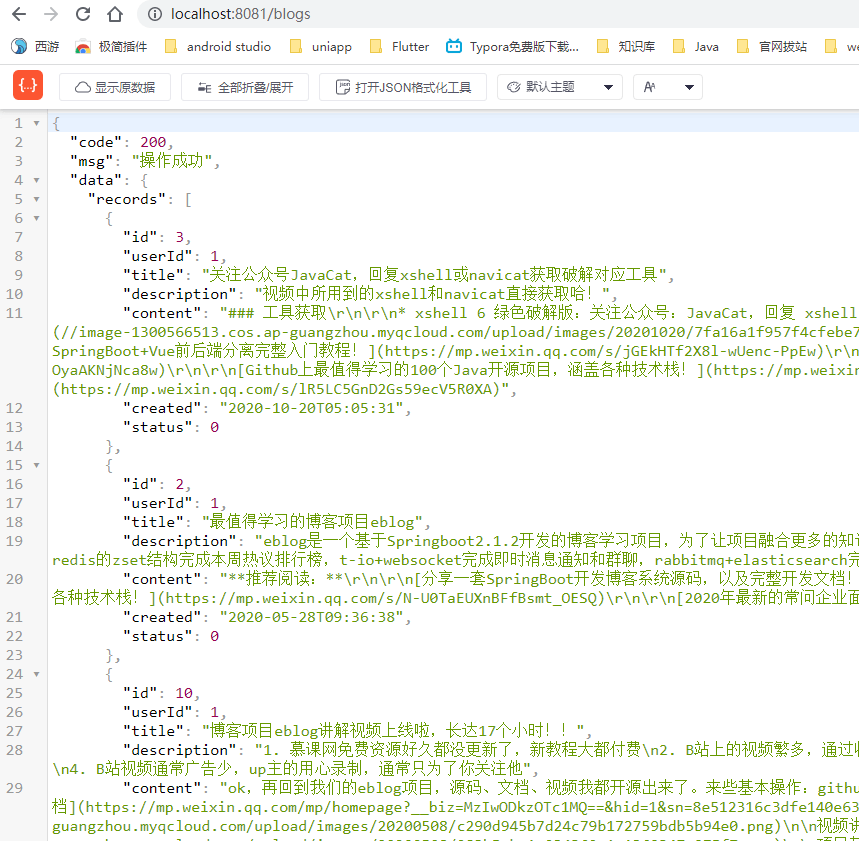
11、后端总结
好了,一篇文章搞定一个基本骨架,好像有点赶,但是基本的东西这里已经有了。后面我们就要去开发我们的前端接口了。
前端部分直接用代码
